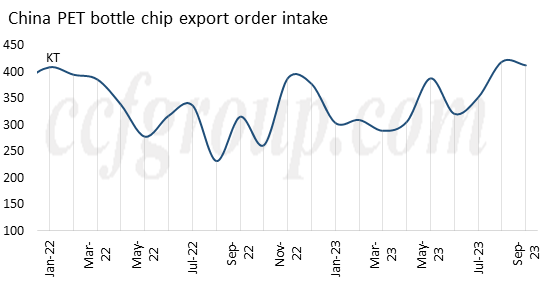PET bottle chip industry run approaches 3-year low
Recently, with the slowdown in delivery speed of downstream market, more news about PET bottle chip factories cutting down output was heard. As of now, closed capacity has exceeded 4 million tons, resulting in a daily production loss of over 13,000 tons. It is estimated that by this weekend, the average utilization rate of domestic PET bottle chip factories will decrease to around 80% (based on the design capacity of 16.01 million tons, or around 72.5% based on the maximum daily production), approaching the lowest level in the past three years.
![Z]5ECPT)]]5{GT@AK16~@80.png Z]5ECPT)]]5{GT@AK16~@80.png](https://pic.ccf.com.cn/2023/10/20231013032714913.png)
After the Mid-Autumn Festival and National Day holidays, the inventory of PET bottle chip factories has generally increased, which has once risen to over 16 days, and some higher even over 20 days or more than a month. Looking at the downstream sector, soft drink enterprises will gradually enter the maintenance period from October to November. They may take turns to turnaround and O/R will gradually decline. O/R of some beverage plants has dropped from full rate to 70-80%.
![V~0N]88W8JZ6M23SIAE_TPL.png V~0N]88W8JZ6M23SIAE_TPL.png](https://pic.ccf.com.cn/2023/10/2023101303271885.png)
In the edible oil industry, the sales this year has been average, with factory operating rates ranging from 60% to 80%. Performance in PET sheet market diverges, with some enterprises in East China maintaining an operation rate of 60-70%, while those in South China have rates around 50-60%, but mostly below 50%. Due to the high price of PET bottle chip in the previous period, PET sheet enterprises have gradually reduced their purchase volume of virgin PET bottle chip by replacing them with recycled bottle flakes and bright chip. Shortly, even though bottle chip prices have been lower than bright chip, the purchasing willingness of PET sheet enterprises is generally weak as raw materials are not used out yet.
In terms of trading sector, some contract traders have a relatively high level of unsold inventory. If they do not receive orders in advance, there may be greater inventory pressure later on. Therefore, after the National Day holiday, they are expected to be more proactive to adjust down price compared to the factories. As a result, the purchasing atmosphere for spot PET bottle chip has cooled down after the first working day of October. However, as prices dropped to the low range, large-scale purchases from downstream beverage manufacturers have gradually emerged, and the trading atmosphere has picked up again this week. Deals done are mainly to be delivered end 2023 and Q1 2024. Some company has already completed their 2024 procurement volume ahead of schedule. At the same time, some traders are also considering moderate replenishment near the low range.
China PET bottle chip export volume totaled 3.1 million tons in the first nine months of the year, a growth of 3.1% compared to the same period last year. PET bottle chip exports were tolerable in Aug-Sep, with monthly volume of over 400,000 tons, which basically covered the export target and provided certain support for domestic sales.
Monthly average export order intake is estimated at 395,000 tons in the third quarter, considering the impact of the October holiday, the average estimated shipment volume from October to December can be around 370,000 tons or more, which can basically maintain the export proportion at around 30-40%. Roughly calculating, the total export volume for 2023 may remain stable or increase slightly compared to last year, estimated to be over 4.6 million tons (comprehensive estimation).

Currently, most PET bottle chip factories are adopting a strategy of cutting production to maintain prices and slow down the increase in inventory. On the other hand, with the decline in raw material costs, there is more operational space for PET bottle chip plants. It's crucial for factories to secure more end-user orders by the end of the year and negotiate new contracts for next year.
- Top keywords
- Cotton Price
- Cotton Futures Price
- Cotton Futures
- CZCE
- PTA Futures Price
- Chemical Fiber
- Polyester Prices
- Wool price
- PTA Futures
- Shengze Silk
- China
- Yarn Price
- price
- China Textile City
- Fibre Price
- Benzene Price
- Cotton
- Index
- Cotton Index
- PTA
- fabric price
- NYMEX
- Top 10
- textile industry
- Spot Cotton
- Cotton Yarn
- Polyester Price
- Futures
- PTA Price
- cotton yarn price

